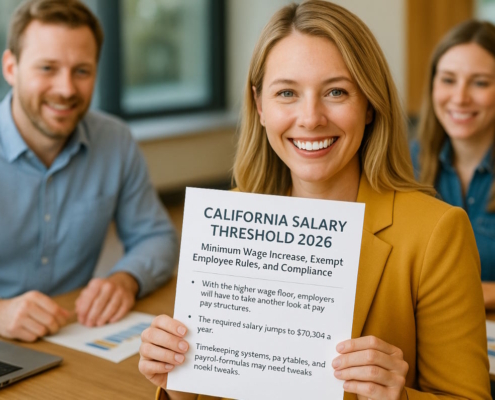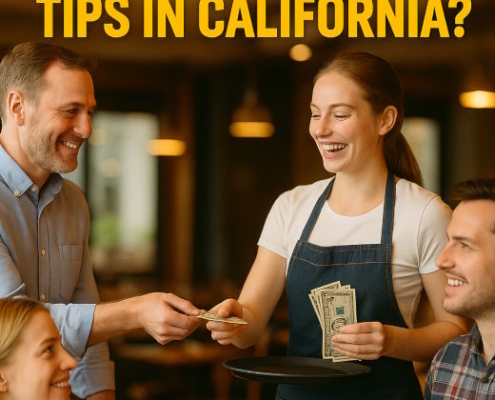Employee Handbook
An employee handbook provides information and detailed guidance on the company’s workplace code of conduct, policies, procedures, values, expectations, working conditions, and behavioral expectations.
Author: Douglas Wade, Attorney
Email | Call (800) 484-4610
The purpose of an employee handbook is to provide information and guidance to employees related to the company’s values, policies, and procedures. Although an employee handbook is not required by law, a company should have a handbook before the first employee is hired. If your company does not have a handbook, employees and supervisors will have no written guidance to ensure that company values and policies are enforced.
When a company has reached the point where it has established many policies and procedures for its employees and staff to follow, it is time for this information to be recorded in writing, both for ease of reference and for legal protection. By recording these policies and procedures in an employee handbook, an employer can streamline his or her business’ process of onboarding new hires. A major advantage of having an employee handbook is that it can organize a company’s administration while also offering a basis for managing disputes between employees. It even has the ability to protect a business owner from legal action. An employee handbook can serve many purposes, all of which benefit the company by ensuring that workers are aware of their own expectations and the rules governing the business.
However, some employers may worry that by creating an employee handbook, they are merely creating a complex manual of requirements that will cause issues down the road. This fear may cause hesitation when they would otherwise greatly benefit from clearly laying out expectations and policies for employees.
Luckily, almost across the board, employee handbooks are not viewed as legally binding. They are not a contract between employee and employer. However, to be safe, an employer should include certain elements in his or her employee handbook that indicate it is not a legally binding contract. These elements include the following:
- A paragraph that explicitly says that the company may add, change, or get rid of policies when it so pleases
- A clear disclaimer that states the handbook is not a legally binding contract and that employment is at will
- A signature page that does not read like an agreement; rather, it presents more as a confirmation receipt
Paste article, 2 of 3 parts. ensure proper formatting.
What should an employee handbook contain?
An employee handbook is also known as a staff handbook or an employee manual. This document explains a company’s rules, policies, and employee expectations. It is not only one-sided; it also explains what employees may rightfully expect from their employer. When a new employee is onboarded, they receive a copy of the company’s employee handbook to review. After they have reviewed the document, they are given a form to sign that states they have read the entire manual and give their consent to its conditions and terms.
While a business does not have to use an employee handbook, it is helpful and important to have one so that employees understand the company’s procedures. A handbook has the benefit of assuring all workers that there are consistent policies and that everyone is treated equally. This means that a junior employee has the same rights as a senior employee, and there is the expectation of fairness.
Having policies set out in an employee handbook contributes to a much safer, positive, and productive work environment. By including the company’s stance on inappropriate behavior in the handbook, there is much less risk of harmful or improper conduct. In this way, a good handbook can protect a company from sexual harassment, wrongful termination, and discrimination lawsuits. If an employee ever sues their company, an employee handbook can act as a defense by proving that certain policies and procedures were in place.
When should you have an employee handbook?
An employee handbook should include a company’s policies and expectations, both relating to the employer and the employee. It should also review the employer’s legal duties as well as the rights of employees.
There is certain information that an employer must present to an employee for legal reasons. The employee handbook serves as a practical place to put this information because it is then available in one place that can later be easily reviewed. Of course, an employer may want to have separate written agreements with an employee regarding specific policies, like intellectual property rights, arbitration of disputes, nondisclosure agreements, and noncompete agreements. It is wise to consult an employment attorney regarding what policies and agreements are suitable for one’s company, according to industry and other factors.
- Equal employment opportunity
- Antiharassment
- Antiretaliation
- At-will employment
- Code of conduct
- Benefits
- General employment information
- Safety and security
- Pay policies, including meal and rest periods, overtime eligibility, timekeeping, and paydays
- Family and medical leave
- Sick leave policy
- Process for filing a complaint
- Paid vacation policy
- Disclaimers (it should be mentioned that the employer may change the handbook policies at any time at their discretion)
- Assessment process for raises and promotions
Other items that can be placed in an employee handbook are mentioned below. These bits of information are less critical, but are included in many companies’ handbooks:
- Welcome letter from founder or CEO
- Company’s mission statement
- Ideal company culture
- Annual office closures
- Standard operating hours
- Dress code and attendance expectations
- Promotion/raise policy
- Progressive discipline or behavior policy
- A form to sign saying that the employee understands the handbook and agrees to the terms and conditions
If an employer desires additional guidance concerning the production of an employee handbook, they may use the following sources for reference:
- United States Department of Labor
- Occupational Safety and Health Administration
A well written employee handbook is essential to an organization’s operation. Once an employer has finished their employee handbook, he or she should make it accessible in an easily accessible format. Usually, companies will save their employee handbook as a PDF or make it available for viewing on the company’s intranet site. It should be noted that a digital copy is simpler to update than a paper copy. In the event of a lawsuit, it is recommended to save previous versions of the handbook and write down dates of any revisions.
How do you write a simple employee handbook?
When putting together an employee handbook, an employer should open with an introduction that provides new workers with a brief overview of the company, as well as the contents of the handbook. This statement should be a reflection of the company’s culture and values.
After, the handbook should delve into specific policies, which should be categorized according to topic, or by non-contractual and contractual status. For instance, an employer may group employee benefits together, and harassment policies separately. Whatever way an employer wishes to design their employee handbook, he or she should be sure to note which policy is contractual and which is non-contractual.
After reviewing their employee handbook, new employees should confirm receipt of the handbook and show that they have read and consented to its contents. This is an especially critical step if the handbook has contractual policies. Consent may be expressed by checking a box, signing a paper copy of the handbook, or sending a confirmation email.
An employer should think about what form he or she wants the handbook to be in. One may choose to use an electronic PDF copy, a copy that is accessible via the company’s intranet, or a hard copy.
Can an employee handbook be changed?
It is good practice for an employer to regularly review their employee handbook. This is important if there have been changes to the company. It is suggested that an employer update their handbook once every year at the very least. If an employer makes reference to any statutory rates in their policies, like pay for sick days, then these should be made current in October and April.
When updates are made to the handbook, staff and employees should be given access to the most updated version for their reference. When an employer makes changes to contractual policies, he or she will need to have their employees agree to the amendments. This is an important step because an employer does not want to risk claims of unfair dismissal or breach of contract. Non-contractual policies, however, may be amended without consulting employees or staff.
Have a quick question? We answered nearly 2000 FAQs.
See all blogs: Business | Corporate | Employment
Most recent blogs:

































